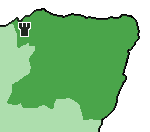
Brodie Castle
Encyclopedia

Castle
A castle is a type of fortified structure built in Europe and the Middle East during the Middle Ages by European nobility. Scholars debate the scope of the word castle, but usually consider it to be the private fortified residence of a lord or noble...
near Forres
Forres
Forres , is a town and former royal burgh situated in the north of Scotland on the Moray coast, approximately 30 miles east of Inverness. Forres has been a winner of the Scotland in Bloom award on several occasions...
in the Moray
Moray
Moray is one of the 32 council areas of Scotland. It lies in the north-east of the country, with coastline on the Moray Firth, and borders the council areas of Aberdeenshire and Highland.- History :...
region of Scotland
Scotland
Scotland is a country that is part of the United Kingdom. Occupying the northern third of the island of Great Britain, it shares a border with England to the south and is bounded by the North Sea to the east, the Atlantic Ocean to the north and west, and the North Channel and Irish Sea to the...
.
The Brodie Family
The original Z-plan castleZ-plan castle
Z Plan is a form of castle design common in England and Scotland. The Z-plan castle has a strong central rectangular tower with smaller towers attached at diagonally opposite corners....
was built in 1567 by Clan Brodie
Clan Brodie
Clan Brodie is a Scottish clan whose origins are uncertain. The first known Brodie chiefs were the Thanes of Brodie and Dyke in Morayshire. The Brodies were present in several clan conflicts, and during the civil war were ardent covenanters...
but destroyed by fire in 1645 by Lewis Gordon
Lewis Gordon, 3rd Marquess of Huntly
Lewis Gordon, 3rd Marquess of Huntly was a Scottish nobleman.He was the third son of George Gordon, 2nd Marquess of Huntly.-Biography:...
of Clan Gordon
Clan Gordon
Clan Gordon, also known as the House of Gordon, is a Scottish clan. The chief of the clan was the powerful Earl of Huntly, now also Marquess of Huntly.-Origins:...
, the 3rd Marquess of Huntly
Marquess of Huntly
Marquess of Huntly is a title in the Peerage of Scotland created on 17 April 1599 for George Gordon, 6th Earl of Huntly. It is the oldest existing marquessate in Scotland, and the second-oldest in the British Isles, only the English marquessate of Winchester being older...
. It was greatly expanded in 1824 by the architect William Burn
William Burn
William Burn was a Scottish architect, pioneer of the Scottish Baronial style.He was born in Edinburgh, the son of architect Robert Burn, and educated at the Royal High School. After training with the architect of the British Museum, Sir Robert Smirke, he returned to Edinburgh in 1812...
who turned it into a large mansion house in the Scots Baronial style.
The Brodie family called the castle home until the late 20th century. It's widely accepted that the Brodies have been associated with the land the castle is built on since around 1160, when it is believed that King Malcom IV
Malcolm IV of Scotland
Malcolm IV , nicknamed Virgo, "the Maiden" , King of Scots, was the eldest son of Earl Henry and Ada de Warenne...
gave the land to the family.
Ninian Brodie of Brodie (The Brodie of Brodie) died in 2003, and his son shortly after. Unfortunately, as his family had been unhappy with the transfer of the castle to the National Trust for Scotland
National Trust for Scotland
The National Trust for Scotland for Places of Historic Interest or Natural Beauty, commonly known as the National Trust for Scotland describes itself as the conservation charity that protects and promotes Scotland's natural and cultural heritage for present and future generations to...
, no Brodie now lives in the castle. The former family wing is being prepared for holiday letting.

Brodie Castle today
Architecturally, the castle has a very well preserved central keep with two 5-storey towers on opposing corners. As with many fortified stately homes of the time it has no wall. It does, however, contain a guardroom and secret passageSecret passage
Secret passages, also commonly referred to as hidden passages or secret tunnels, are hidden routes used for stealthy travel. Such passageways are sometimes inside buildings leading to secret rooms. Others allow occupants to enter or exit buildings without being seen...
s to help the occupants escape assassination attempts. The interior of the castle is also well preserved, containing fine antique furniture, oriental artifacts and painted ceilings
Today the castle and surrounding policies, including a notable daffodil collection, are owned by the National Trust for Scotland and open to tourists throughout the summer months. The castle may be hired for weddings and indoor or outdoor events. An ancient Pictish
Picts
The Picts were a group of Late Iron Age and Early Mediaeval people living in what is now eastern and northern Scotland. There is an association with the distribution of brochs, place names beginning 'Pit-', for instance Pitlochry, and Pictish stones. They are recorded from before the Roman conquest...
monument known as Rodney's Stone
Rodney's Stone
Rodney's Stone is a two-metre high Pictish cross slab now located close on the approach way to Brodie Castle, near Forres, Moray, Scotland. It was originally found nearby in the grounds of the old church of Dyke and Moy. It is classed as a Class II Pictish stone, meaning that it has a cross on one...
can be seen in the castle grounds.
See also
- Clan BrodieClan BrodieClan Brodie is a Scottish clan whose origins are uncertain. The first known Brodie chiefs were the Thanes of Brodie and Dyke in Morayshire. The Brodies were present in several clan conflicts, and during the civil war were ardent covenanters...
- List of castles in Scotland
- List of places in Moray

